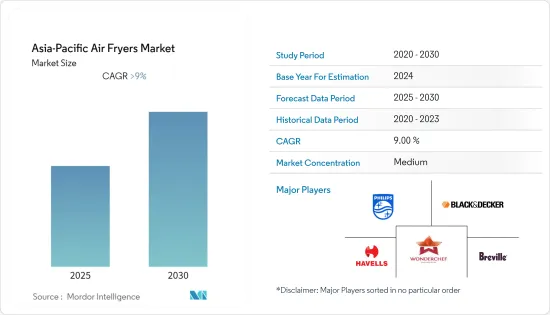
|
市場調査レポート
商品コード
1636154
アジア太平洋地域のエアフライヤー:市場シェア分析、産業動向、成長予測(2025~2030年)Asia-Pacific Air Fryers - Market Share Analysis, Industry Trends & Statistics, Growth Forecasts (2025 - 2030) |
||||||
カスタマイズ可能
適宜更新あり
|
|||||||
| アジア太平洋地域のエアフライヤー:市場シェア分析、産業動向、成長予測(2025~2030年) |
|
出版日: 2025年01月05日
発行: Mordor Intelligence
ページ情報: 英文 150 Pages
納期: 2~3営業日
|
全表示
- 概要
- 目次
アジア太平洋地域のエアフライヤー市場は、予測期間中に9%を超えるCAGRで推移すると予想されています。

COVID-19以降、人々はエアフライヤーを従来の油で揚げる方法に比べてはるかに健康的な選択肢とみなしました。それゆえ、健康とフィットネスへの志向が高まり、製品の認知度と需要が高まった。
多忙なライフスタイルは、大多数の人々の食習慣に変化をもたらしました。食習慣の変化は、すぐに食べられる食品の需要増につながり、QSRホテルやレストランの増加につながった。HORECA業界のエンドユーザーは、効率を高めるために、より先進的でコンパクトかつ効果的な機器を積極的に求めています。このようなエアフライヤーを含む高度な調理機器に対する需要の増加は、近い将来の収益成長を促進すると予想されます。
アジア太平洋地域のエアフライヤー市場動向
都市化がエアフライヤーの普及に影響
キッチン用品に対する農村部と都市部の消費者の認識は異なっています。キッチン用品は都市部の個人の個性を表現する商品とみなされ、農村部の人々は一般的にキッチン用品を実用的な商品とみなしています。都市部の消費者は、洗練された美的感覚を持ち、高価な製品を買いたがります。可処分所得や世帯所得の増加、健康意識の高まりから、都市部の人々はエアフライヤーを購入する傾向が強いです。エアフライヤー市場は、不健康な食習慣による心臓疾患の増加により、人々の健康に対する意識が高まっていると説明します。これには食生活の見直しと健康的な食品の使用が含まれます。エアフライヤーのコンセプトは、油の消費を抑えながら揚げ物を食べることができます。多くの労働者階級が調理器具製品の販売を支え、低油調理器具の需要を牽引しています。
商業部門での需要
低油性食品への需要は、商業部門にも大きな影響を与えています。ホテルやレストランは、低油性調理器具の採用に向かっています。需要はホテルやレストランだけにとどまらず、病院でも見られます。患者の厳しい食事要求により、病院は低油の調理済み食品を提供するようになり、これが市場でエアフライヤーの需要をさらに生み出しています。
アジア太平洋地域のエアフライヤー産業の概要
アジア太平洋地域のエアフライヤー市場は細分化された産業です。エアフライヤーの成長の主な要因は、調理時間が短いこと、散らからないこと、油の使用が最小限であることです。エアフライヤーで食品を揚げる際に使用される油は、ほとんど洗い流されます。技術の進歩と製品の革新により、中堅から中小企業が市場での存在感を高めています。この市場の主なプレーヤーは以下の通りです。 Philips, Black & Decker, Havells, Wonderchef and Breville.
その他の特典:
- エクセル形式の市場予測(ME)シート
- 3ヶ月間のアナリスト・サポート
目次
第1章 イントロダクション
- 調査の前提条件と市場定義
- 調査範囲
第2章 調査手法
第3章 エグゼクティブサマリー
第4章 市場力学と洞察
- 市場概要
- 市場促進要因
- 消費者の健康志向の高まり
- 市場抑制要因
- 偽造品の流通
- 市場機会
- エアフライヤーの技術進歩
- 業界バリューチェーン分析
- 業界の魅力度-ポーターのファイブフォース分析
- 買い手の交渉力
- 供給企業の交渉力
- 新規参入業者の脅威
- 代替品の脅威
- 競争企業間の敵対関係
- 市場における技術革新に関する洞察
- COVID-19の市場への影響
第5章 市場セグメンテーション
- 製品タイプ別
- 手動式エアフライヤー
- デジタル・エアーフライヤー
- エンドユーザー別
- 商業
- 住宅
- 流通チャネル別
- オフライン
- オンライン
- 国別
- 中国
- 日本
- インド
- その他アジア太平洋地域
第6章 競合情勢
- 市場集中の概要
- 企業プロファイル
- Philips
- Black & Decker
- Havells
- Wonderchef
- Breville
- Groupe SEB
- NuWave,LLC
- Cuisinart Corporation
- Meyer Manufacturing Company Ltd.
- De Longhi Appliances
第7章 市場動向
第8章 免責事項と出版社について
The Asia-Pacific Air Fryers Market is expected to register a CAGR of greater than 9% during the forecast period.

After COVID-19, people considered air fryers as a much healthier option compared to traditional frying methods in oil. Hence, the increasing inclination towards health and fitness bolstered product awareness and demand.
Busy lifestyles have led to changes in the eating habits of the majority of the population. Changes in eating habits have led to increasing demand for ready-to-eat-food products, which led to a rise in the number of QSR hotels and restaurants. The end user from the HORECA industry is actively seeking more advanced, compact, and effective equipment to increase their efficiency. This increasing demand for such advanced cooking equipment, which includes air fryers, is anticipated to propel revenue growth in the near future.
Asia-Pacific Air Fryers Market Trends
Urbanization Influencing the Adoption of Air Fryers
Rural and urban consumer perceptions of kitchenware are different. Kitchen products are seen as products that express the personality of urban individuals; those in rural areas generally view kitchen products as utilitarian products. Individuals from urban areas are keen to buy products with sophisticated aesthetics and high costs. Due to increasing disposable and household incomes and health awareness, the urban population is more likely to purchase air fryers. The air fryer's market explains that the rising number of heart diseases due to unhealthy eating habits is making people more aware of their health practices. This involves a change of diet and the use of healthy food items. The concept of an air fryer lets one eat fried food while limiting oil consumption. A large working-class population supports the sales of cookware products, driving the demand for low-oil cooking appliances.
Demand in Commercial sector
Demand for low-oil-based food has had a significant impact on the commercial sector. Hotels and restaurants have moved towards the adoption of low-oil-based cooking appliances. The demand is not only limited to hotels and restaurants but it is also witnessed in hospitals. Strict dietary requirements of patients have pushed hospitals to provide low-oil cooked food, which further creates demand for air fryers in the market.
Asia-Pacific Air Fryers Industry Overview
The Asia-Pacific Air Fryers Market is a fragmented industry. The major factors responsible for the growth of air fryers are less cooking time, no mess, and minimal use of oil. The oil used in frying a food item in the air fryer is mostly brushed off. With technological advancement and product innovation, mid-size to smaller companies are increasing their market presence. Some of the major players in this market are Philips, Black & Decker, Havells, Wonderchef and Breville.
Additional Benefits:
- The market estimate (ME) sheet in Excel format
- 3 months of analyst support
TABLE OF CONTENTS
1 INTRODUCTION
- 1.1 Study Assumptions and Market Definition
- 1.2 Scope of the Study
2 RESEARCH METHODOLOGY
3 EXECUTIVE SUMMARY
4 MARKET DYNAMICS AND INSIGHTS
- 4.1 Market Overview
- 4.2 Market Drivers
- 4.2.1 Increasing health consciousness among consumers
- 4.3 Market Restraints
- 4.3.1 Availability of counterfeit products
- 4.4 Market Opportunities
- 4.4.1 Technological advancements in air fryers
- 4.5 Industry Value Chain Analysis
- 4.6 Industry Attractiveness - Porter's Five Forces Analysis
- 4.6.1 Bargaining Power of Buyers
- 4.6.2 Bargaining Power of Suppliers
- 4.6.3 Threat of New Entrants
- 4.6.4 Threat of Substitutes
- 4.6.5 Intensity of Competitive Rivalry
- 4.7 Insights on technology innovation in the Market.
- 4.8 Impact of COVID-19 on the Market
5 MARKET SEGMENTATION
- 5.1 By Product Type
- 5.1.1 Manual Air fryer
- 5.1.2 Digital Air fryer
- 5.2 By End Users
- 5.2.1 Commercial
- 5.2.2 Residential
- 5.3 By Distribution Channel
- 5.3.1 Offline
- 5.3.2 Online
- 5.4 By Country
- 5.4.1 China
- 5.4.2 Japan
- 5.4.3 India
- 5.4.4 Rest of the Asia-Pacific
6 COMPETITIVE LANDSCAPE
- 6.1 Market Concentration Overview
- 6.2 Company Profiles
- 6.2.1 Philips
- 6.2.2 Black & Decker
- 6.2.3 Havells
- 6.2.4 Wonderchef
- 6.2.5 Breville
- 6.2.6 Groupe SEB
- 6.2.7 NuWave,LLC
- 6.2.8 Cuisinart Corporation
- 6.2.9 Meyer Manufacturing Company Ltd.
- 6.2.10 De Longhi Appliances*


